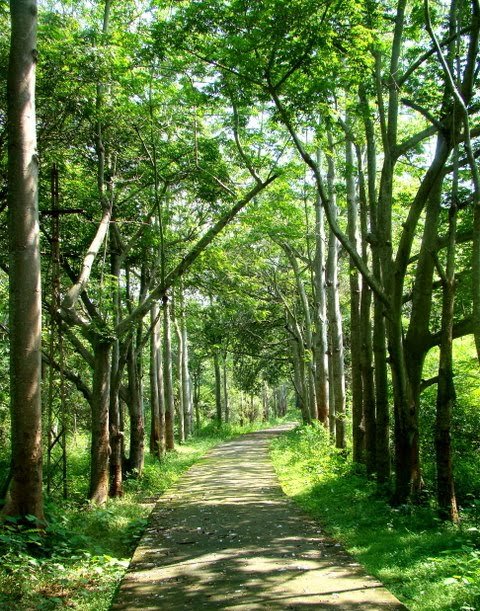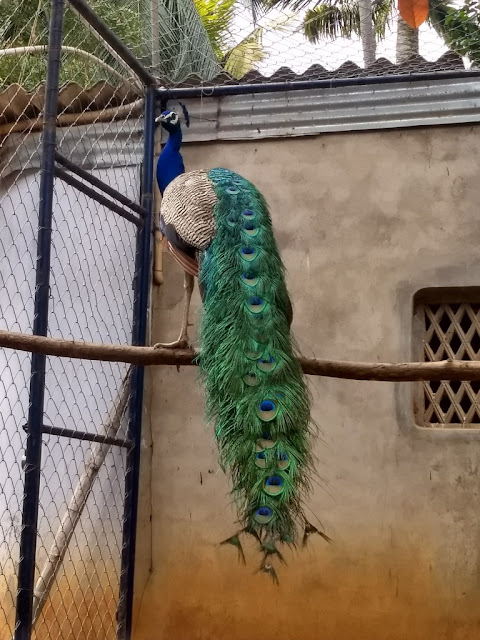Udayagiri Fort, Puliyoorkurichi, Kanyakumari
Udayagiri
Fort is located at Puliyoorkurichi on the Thiruvananthapuram –Nagercoil
National Highway in Kanyakumari District of Tamilnadu. This fort, also known as
De Lannoy's Fort or Dillannai Kottai, stands as a remnant of the historic
Travancore regime. It is built of massive granite blocks and it covers an area
of 90 acres, enclosed by isolated hills that are almost 260 feet in height. Udayagiri
Fort was named after the King Udayanan of Padmanabhapuram.
This
fort was the camping and training ground for the king’s army. Some remains of
the furnace used for making ammunition can still be seen. Today the fort is
a natural park with
a tree house, herbal garden, deer and bird enclosures, and an aquarium. This
was the most important military barracks of the Travancore rulers, when Padmanabhapuram was their capital.
History
Udayagiri
Fort is an ancient fort which was constructed in 1600 AD. The fort is said to
have been destroyed during war. The fort was rebuilt during the reign of
Marthanda Varma, between 1741-44 under the supervision of Eustachius De Lannoy, a Flemish naval commander of the Dutch East India
Company, who later served as the Chief of the Travancore Army. De Lennoy was one of the 24 European
prisoners taken by King Marthanda Varma in 1741 when he was defeated the Dutch
at Colachel. He joined King Marthanda Varma and became the trusted General of
Marthanda Varma and remained loyal to him for 37 years. He trained the
Travancore Soldiers in the European method of fighting.
As a
Christian, De Lannoy was prohibited from entering the king’s palace at
Padmanabhapuram and he resided primarily at Udayagiri Fort, or Dillanai Kotta
(De Lannoy’s Fort) as it is locally called, where he also built a small chapel
for his family and other Christians. Captain De Lannoy’s military skills and
trust were recognized not only by King and the state officials, but also by the
subjects of Travancore, who called him by the nom de guerre ‘Valia Kaaptain’
(meaning 'valiant Commander'). De Lannoy died a natural death in 1777. De
Lannoy's tomb in the fort is marked out by a stone cross planted at the top,
with the inscription in both Tamil and Latin. His wife and son are also buried
by his side.
De
Lannoy, who was trusted and liked by both the king and his subjects was buried
at the chapel inside Udayagiri fort. In the early days, the fort was of strategic
importance. Prisoners captured in the campaign against Tippu
Sultan were confined in the fort for some time. In
1810, the East India Company's Army under Colonel Leger marched into Travancore
through the Aramboly Pass (Aralvaimozhi) to quell a rebellion under the
leadership of Velu Thambi Dalawa. In later years, English East India Company
troops were stationed at the fort until the middle of the 19th century.
A
foundry for the manufacture of guns, mortars and cannonballs was established
within the fort under the supervision of the resident General. A village has
come up in front of the fort. The people who live here, are mostly
agriculturists. A few of them are engaged in trade. Pottery making is the chief
Industry among a section of the people. Now, the District Administration, with
the help of Forest Department has set up a Biodiversity Park over here.
Tourists can see deer, ducks, fountains, birds and over 100 varieties of trees
inside the fort.
The Fort
Udayagiri
Fort covers an area of about 90 acres (36 ha), with an isolated hill 260
feet (79 m) high, the fort contains an old foundry which was used for
casting guns. The fort is built of massive granite blocks around an isolated
hillock. This was the most important military barracks of the Travancore
rulers, when Padmanabhapuram was their capital. Prisoners captured in
the campaign against Tippu Sultan were confined in this fort for some
time.
Presently,
the fort has been turned into a bio-diversity park by the Tamil
Nadu forest department, with sites of historical
importance, such as De Lannoy's tomb, remaining as protected archaeological
sites under the Archaeological Department of India. It is said that a brass gun
16 ft. long bored as a 22 ponder, found in the fort could not be removed even
for a few yards by many people, even with the help of 16 elephants.
De
Lannoy's body was buried within the fort and a chapel was built at his burial
site. De Lannoy's tombstone lies within the walls of the ruined chapel. The
inscriptions on his stone are both in Tamil and in Latin. His wife and son were
buried by his side. The tombs of the Dutch Admiral Eustachius De Lannoy, (in
whose honour the fort was once called Dillanai Kottai – De Lennoy's Fort), and
of his wife and son can still be found inside a partly ruined chapel in the
fort.
There is
a wildlife park inside this fort. There are around 13 types of wild animals, 50
types of birds and 60 types of forest trees in this park. There is also a park
for children. There was a small building nearby, inside which there was an
aquarium. An artificial fountain has also been established in the fort. Recently,
officials of the Department of Archaeology found an underground tunnel within
the fort. The roads inside were neatly laid and we all are ready to take a
stroll through these roads.
Operating
Hours & Entry Fees
·
Mon – Sun: 09:30 AM -
05:30 PM
·
Entry Fee: Rs. 5/-
Connectivity
Udayagiri
Fort is located at Puliyoorkurichi on the Thiruvananthapuram –Nagercoil
National Highway. The fort is close to Padmanabhapuram palace, won't take more
than 10 minutes to reach from the palace. Udayagiri Fort is located at about 2
Kms from Padmanabhapuram Palace, 3 Kms from Thuckalay, 14 Kms from Colachel, 16
Kms from Marthandam, 18 Kms from Kulasekharam, 19 Kms from Kuzhithurai, 6 Kms
from Eraniel, 14 Kms from Nagercoil, 20 Kms from Boothapandi, 33 Kms from
Kanyakumari and 62 Kms from Thiruvananthapuram. Nearest Railway Station is
located at Eraniel and Nearest Airport is located at Thiruvananthapuram.












































